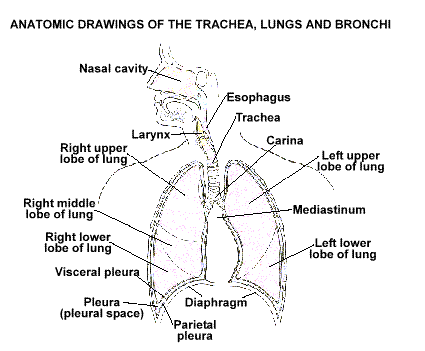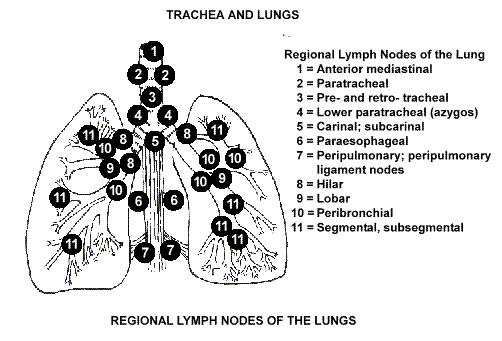

This is a review of some of the basic facts that are related to lung cancer. It compliments our Comprehensive Report on Lung Cancer which focuses mainly on state-of-the-art treatment protocols, experimental clinical trials that are open, and current research. For details on that report, see the link. If you care to print this file, it is about 9 pages.
Lung cancer is a disease in which transformed cells (neoplasms) arise in the tissues of the lung. It can be divided into two types: small cell lung cancer and non-small cell lung cancer. The cancer cells of each type grow and spread in different ways, and they are treated differently. Non-small cell lung cancer is usually associated with prior smoking, passive smoking, or radon exposure. Lung occurs only in males and females alike. In the U.S., there were about 164,000 new cases of lung cancer diagnosed in the year 2000, and there was a total of about 413,000 standing cases. The life-time risk of being diagnosed with lung cancer is about 8% for males and 6% for females, and the life-time risk of dying from lung cancer is 6.7% for males and 4.6% for females.
There are seven diagnostic stages of lung cancer, Occult, Stages 0, I, II, II, & IV, plus recurrent.
Occult stage. Cancer cells are found in sputum, but no tumor can be found in the lung.
Stage 0. Cancer is only found in a local area and only in a few layers of cells. It has not grown through the top lining of the lung. Another term for this type of lung cancer is carcinoma in situ.
Stage I. The cancer is only in the lung, and normal tissue is around it.
Stage II. In stage II, cancer has spread to nearby lymph nodes or to the chest wall (the ribs and muscles that make up the area of the body between the neck and the abdomen), the diaphragm (the thin muscle below the lungs and heart that separates the chest from the abdomen), the mediastinal pleura (the thin membrane that covers the area between the lungs), or the parietal pericardium (the outer layer of tissue that surrounds the heart). Stage II is divided into stage IIA and stage IIB, based on the size of the tumor and whether it has spread to the lymph nodes.
Stage III. Cancer has spread to the chest wall or diaphragm near the lung; or the cancer has spread to the lymph nodes in the area that separates the two lungs (mediastinum); or to the lymph nodes on the other side of the chest or in the neck. Stage III is further divided into stage IIIA (usually can be operated on) and stage IIIB (usually cannot be operated on).
Stage IV. Cancer has spread to other parts of the body.
Recurrent. Cancer has come back (recurred) after previous treatment.
The conventional treatments are: surgery, chemotherapy, and radiation. As of January 2002, there were over 118 active, experimental, clinical trials that are being conducted, and during 2001 there were about 3,600 research reports which were published on lung cancer, both of which indicate a high degree of research activity.
In our Comprehensive Report on Lung Cancer, we detail the various stages and therapeutic alternatives. The experimental trials are listed and the most recent research citations are provided. The report is a component of what we call The Life-extension Approach to Medicine.
Below is some graphic information that is relevant to lung cancer. (The data are taken from The Surveillance, Epidemiology, and End Results (SEER) Program of the National Cancer Institute.)
Anatomical sites that are associated with lung cancer are below.   |
Total Incidence of Lung Cancer. Incidence means the number of cases of the disease per year per 100,000 population (U.S.). It provides an idea about the magnitude of the disease, whether some change in condition is causing an increase or decrease, and whether preventive measures are being effective.
Comments. The total incidence in lung cancer has remained, essentially, unchanged over the last three decades. For males, in 1973 the incidence was 73 per 100,000 and in 1998 it was 69 per 100,000, which is not much improvement. For females, in 1973, the incidence was 18 per 100,000 and in 1998 it was 43 per 100,000, which represents a dramatic, 137%, increase probably due entirely to the increase of smoking in females.
Incidence of Lung Cancer by Age Category. This analyzes the incidence by specific age groups per 100,000 population.
Comments. In both males and females, there is a strong correlation between lung cancer and biological ageing, suggesting that a systemic deterioration, perhaps in the immune system or neuro-endocrine regulation or extra-cellular matrix, might be a primary, causative agent. Lung cancer will not be preventable unless and until biological ageing is cured.
Death or Mortality Rates of Lung Cancer. This is a measure of the number of persons dying from the disease per 100,000 population per year. It provides an idea about whether medical therapies are being effective.
Comments. The total death rate in lung cancer has increased in both sexes over the last three decades. For males, in 1973 the mortality reate was 62 per 100,000 and in 1998 it was 65 per 100,000. For females, in 1973 the incidence was 13 per 100,000 and in 1998 it was 34 per 100,000 - again, a dramatic increase due to smoking.
Mortality or Death of Lung Cancer by Age Category. This breaks-out the total mortality above by specific age groups within a given age cohort as an average for a period of 4 years.
Comments. Again, there is a strong correlation between death from lung cancer and biological ageing, suggesting that a systemic deterioration, perhaps in the immune system or neuro-endocrine regulation or something more fundamental such as exta-cellular matrix deterioration, might be a primary, causative agent.
Survival Rates of Lung Cancer. These data show, at different epochs, the percentage of persons surviving the disease over a 5 year period.
Comments. In 1975, of those who were diagnosed with lung cancer, only 34% were still alive after year 1 and 12% were alive at year 5. In 1993, the percentages improved moderately to 41% and 14% respectively. This low survival rate is due to the virility of the disease and the inability to diagnose it until a late stage of development.
The Status of Research. One measure of potential progress on a particular disease is the amount of research which is being done. In the MEDLINE database, the number of reports on lung cancer has steadily increase.
Also, the main funding agency for cancer in the U.S. has steadily increased its budget to about $3.25 billion annually and a fair portion of that goes to lung cancer.
Comments. Research on lung cancer receives considerable funding; and the number of research reports on lung cancer continues to accelerate. In spite of that, only modest progress has been realized in prevention and cure. In our Comprehensive Report on Lung Cancer, we enable people to become directly involved in moving this science forward.
Return to Home Page